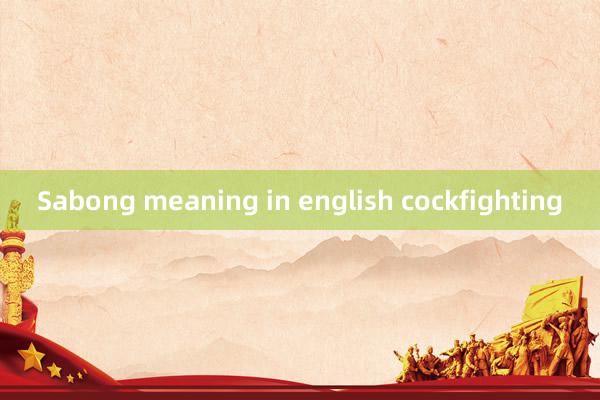
Sabong Meaning in English: Understanding Cockfighting
Sabong, a traditional Filipino term, refers to cockfighting, a popular cultural and social event in the Philippines that has been practiced for centuries. While it might be seen as a form of entertainment, its history and significance in Filipino culture go much deeper than just a spectator sport. In this article, we will explore the meaning of sabong in English, delving into the roots of cockfighting, its cultural impact, and the controversies surrounding the practice today.
Historical Roots of Sabong
Cockfighting, or sabong, has a long history in the Philippines, believed to have been introduced by early Malay settlers. The sport involves two roosters, usually specially bred and trained, fighting in a ring until one is declared the winner. This activity was not only for entertainment but also a symbol of prestige and status for the participants.
The term "sabong" itself comes from the Filipino language, but the activity has strong ties to many ancient cultures, not just in the Philippines but across Asia and the world. Historical records suggest that cockfighting dates back to 6,000 years ago, with evidence found in places like India, China, and even Greece. Despite its global roots, sabong has been deeply embedded into the Philippine cultural fabric, phim xet đồng tính nữ evolving into a national pastime.
Sabong as a Cultural Practice
In the Philippines, phim sex móc lồn nhật bản sabong is more than just a sport; it is a deeply ingrained tradition that transcends generations. Cockfighting arenas,phcrown known as cockpits, can be found throughout the country, where fans gather to watch and bet on their chosen roosters. For many, the sport serves as a social event, where families and friends come together to bond, share stories, and even discuss important matters in their communities.
Roosters used in sabong are not just ordinary birds. They are carefully bred and trained for months to ensure their physical readiness for the match. Owners take great pride in their birds, often seeing them as extensions of their status and skill in raising a champion. A winning rooster brings not only financial rewards but also recognition and respect within the community.
For some Filipinos, sabong is viewed as a representation of masculinity and bravery. The roosters symbolize strength, resilience, and the ability to fight against adversity, traits that are admired in Filipino society. This cultural aspect helps explain why cockfighting has remained popular for so long, even as modern attitudes toward animal welfare evolve.
The Betting Aspect of Sabong
tải go88Another important component of sabong is the betting culture surrounding the matches. People from all walks of life come together to place bets on their preferred rooster. The wagers can range from small amounts to substantial sums, depending on the confidence in the rooster's abilities. For many, this betting aspect adds an extra layer of excitement to the event.
Betting on cockfights is often seen as a form of economic activity for locals, particularly in rural areas where job opportunities may be scarce. The winnings from successful bets can supplement income, making sabong not only a pastime but also a source of livelihood for some. This financial dimension further solidifies sabong's importance in Filipino society.
Controversies and Legal Issues
While sabong holds a special place in Filipino culture, it is not without its controversies. In modern times, animal rights activists and various organizations have raised concerns about the ethical treatment of the roosters involved in these fights. Critics argue that cockfighting promotes cruelty to animals, as the birds often suffer serious injuries or die during matches. The sharp blades, known as gaffs, attached to the roosters' legs during the fight only intensify these concerns.
In response to these criticisms, certain local governments have attempted to regulate or even ban sabong in some areas. However, despite these efforts, the sport continues to thrive, especially in regions where it remains deeply embedded in the culture. Legal cockfighting is still widely permitted in designated arenas, though illegal and underground matches sometimes occur, drawing further scrutiny from law enforcement.
Additionally, the rise of e-sabong (online cockfighting) in recent years has sparked new debates. E-sabong allows individuals to watch and bet on cockfights remotely, using online platforms. While this has provided a new avenue for fans to engage in the sport, it has also led to concerns about gambling addiction and the potential for increased illegal betting activities.
Sabong's Future in the Philippines
Despite the growing controversies surrounding sabong, it remains a resilient tradition in Filipino culture. Efforts to regulate the sport, as well as rising concerns over animal rights, may shape its future, but the cultural significance of sabong will likely continue to hold sway over many Filipinos.
In conclusion, sabong or cockfighting is a centuries-old tradition that has evolved into a national pastime in the Philippines. It represents much more than just a form of entertainment; it is a cultural and social event that brings people together. However, as global attitudes toward animal welfare and ethics evolve, the future of sabong may face new challenges. Regardless of these issues, the deep-rooted connection between sabong and Filipino identity will likely ensure its ongoing relevance for years to come.
63win registerwww.hongkong-tour.com


